Although there have been many books written about the Japanese-American internment, only some of them even mention the newsletters produced at the camps and, at most, they generally will have only one or two pages from one of the issues.
This is leaving out one of the most historically interesting and important aspects of the internment. The newsletters that were produced give the day-to-day news of interest to the community of those who were interned. I am sure that there were restraints on what the newsletters were allowed to print, but they still tend to contain a wealth of interesting material.
I will review five issues per section.
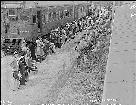
Persons of Japanese ancestry arrive at the Santa Anita Assembly center from San Pedro, California. Evacuees lived at this center at the Santa Anita race track before being moved inland to relocation centers. |
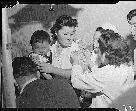
Evacuees of Japanese ancestry are being vaccinated by fellow evacuees upon arrival at Assembly centers. |
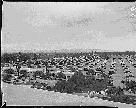
A panoramic view of the Santa Anita Assembly center showing barrack apartments on the former race track grounds for evacuees of Japanese ancestry. They will later be transferred to a War Relocation Authority center to spend the duration. |

Newcomers at Santa Anita assembly center receive vaccination against small pox and typhoid fever. Under direction of Doctor Norman Kobayashi and nurses who are also evcauees of Japanese ancestry, they pass through the hospital at a rate of 400 per hour. Evacuees are transferred later to War Relocation Authority centers for the duration. |

Military police on duty in watch-tower at Santa Anita park assembly center for evacuees of Japanese ancestry. Evacuees are transferred later to War Relocation Authority centers for the duration. |
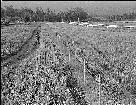
Military police patrol fence around Santa Anita park assembly center for evacuees of Japanese ancestry. Evacuees are later transferred to War Relocation Authority centers for the duration. |

To insure cleanliness and to protect health, modern dish-washing apparatus is used to sterilize dishes for thousands of meals at Santa Anita assembly center for evacuees of Japanese ancestry. |
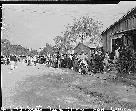
Cafeteria style assures promptness in serving meals at Santa Anita assembly center for evacuees of Japanese ancestry. Passing into dining hall for lunch. In the smallest dining hall, more than 2000 meals are served in less than an hour. Evacuees are transferred later to War Relocation Authority centers for the duration. |
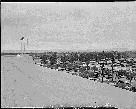
Bird's-eye view of quarters for evacuees of Japanese ancestry at Santa Anita assembly center. Evacuees will be transferred later to War Relocation Authority centers for the duration. |
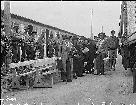
Evacuees of Japanese ancestry from San Pedro, California, arrive by special trains for Santa Anita assembly center. Evacuees are transferred later to War Relocation Authority centers for the duration. |
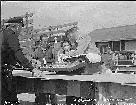
All baggage is inspected before newcomers enter Santa Anita assembly center for evacuees of Japanese ancestry. Evacuees are transferred later to War Relocation Authority centers for the duration. |
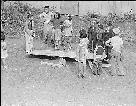
An impoverished ping pong table collapses in the midst of a game among youngsters at Santa Anita assembly center for evacuees of Japanese ancestry. Evacuees are transferred later to War Relocation Authority centers where they will spend the duration. |

Mrs. Lily Okura, with necktie rack, carpet and shelves, begins housekeeping at Santa Anita assembly center for evacuees of Japanese ancestry. Evacuees are transferred to War Relocation Authority centers for the duration < |

Entering her new temporary apartment at the Santa Anita Assembly center to await transfer to a War Relocation Authority center where evacuees of Japanese ancestry will spend the duration. |

At the entrance of their barrack apartment at the Santa Anita Assembly center. As soon as housing facilities are made available, evacuees of Japanese ancestry will be transferred to War Relocation Authority centers to spend the duration. |

Evacuees watching transformation of Santa Anita race track into assembly center where evacuees of Japanese ancestry from Southern California are being housed until facilities are available at War Relocation Authority centers, now under construction. |
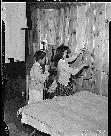
Evacuees of Japanese ancestry are getting settled in their temporary quarters at the Santa Anita Assembly center. Later they will be transferred inland to War Relocation Authority centers to spend the duration. |

Cooks of Japanese ancestry prepare meals for thousands of evacuees at the Santa Anita Assembly center. |

Four young evacuees of Japanese ancestry are tucked in bed for an afternoon nap at Santa Anita Assembly center. |
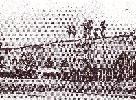 Construction underway on the center |
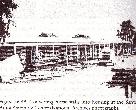
Horse stalls being changed into housing. |
 Newly constructed barracks |
This was the longest occupied assembly center, from March 27 to October 27, 1942. It was also one of the largest assembly centers with around 19,000 total housed. 8,500 of the people lived in the converted horse stalls. There is no historical marker there, unfortunately. The barracks are gone, but the grandstand, some racetrack buildings and some horse stalls still remain.
One of the earliest disturbances among the evacuees was at Santa Anita and occurred on June 16, 1942. 1200 evacuees involved in making camouflage nets struck for higher wages and better living conditions, including a liberal supply of food. Handbills had been given out by someone who was a Japanese Communist, calling for a strike on July 1, 1942. The demands were to work a four-hour day, get $41 per month for their work, medical protection, discharge of the current foreman and no women workers. The handbill went on to say that there is no democracy for the Japanese in the U.S. and that they are being required to perform unhygienic work which prisoners in state institutions had refused to do.
The strike was settled peacefully and by June 19 all workers had returned to their jobs. The wages were increased, but only from $8 per month to a total of $12 per month.
On June 24, 1942, five citizens of Japanese descent were arrested at the center by the U.S. Marshall under a warrant issued upon a complaint charging conspiracy to defraud the Government by interfering with the proper execution of Public Law 503, 77th Congress, in that they held an unauthorized meeting in the Japanese language.
Another problem started on August 4, 1942, and a description of the problem is in the Final Report: Japanese Evacuation from the West Coast, 1942, published June 5, 1943:"At Santa Anita on August 4, 1942, a routine search for various articles of contraband was started immediately after the morning meal. A few of the interior security police became over-zealous in their search and somewhat overbearing in their manner of approach to evacuees in two of the Center's seven districts. Added to this was an order from the Center Manager to pick up, without advance notice,, electric hot plates which had previously been allowed on written individual authorization of the Center Management staff to families who needed them for the preparation of infant formulas and food for the sick. Electric devices, such as hot plates, were strictly controlled to prevent fire.
"Poor liaison, or rather the complete lack of liaison in this incident, between the Center Management and the heads of the interior security police resulted in the failure of reports of complaints to reach the chief of interior security police until mid-afternoon. Those complaints, based to a certain extent on solid ground grew in the intervening four or five hours to rumors of all kinds of violations on the part of the police. When finally the complaints reached the chief of interior police, the search was promptly postponed just as the crowds were beginning to gather.
"Two mobs and one crowd of women evacuees formed. One evacuee who had long been suspected by the disorderly elements among the population of giving information to the police was set upon and severely beaten though not seriously injured. The interior security police were harassed but none were injured."
"This is the single instance...in which the military police were called into the Center and took complete charge upon entering. No further disturbance occurred after the military police entered. The crowds dispersed, and no further threats of violence were circulated and no actual attempts at violence occurred."
It is interesting to see how two government reports can give two widely varying descriptions of the same event. The report above basically makes it look like the government's fault for the trouble. The following report, from Riots, Strikes and Disturbances in Japanese Relocation Centers -1943, takes a quite different approach:
"At about 8:30 A.M. on August 4, 1942, the Interior Police at the Assembly Center commenced a search of the houses occupied by the Japanese for articles which they were not permitted to possess under the rules of the Center. The search continued until about 2:30 P.M., and resulted in the discovery of two truckloads of prohibited articles, including sugar, whiskey and Government property consisting of silverware and towels. Much of this material was buried beneath th floors of the houses or otherwise secreted. About 2:30 P.M.>, a gathering of about 150 Japanese women and children protested to the Chief of the Interior Police that the searches were being made without warrants, and that electrical devices such as hot plates were being seized. They were advised that the electrical devices were seized because they had resulted in the overloading of the electric lines. While the women and children were engaging the attention of the Chief of Police, rioting broke out and continued in various parts of the Center. A group of about 3000 Japanese rioted at one of the mess halls. Another group of approximately 4000 engaged in a riot in the vicinity of one of the gates. Approximately 3000 Japanese converged upon the Police Headquarters, within which there were several police officers and two Agents of the Federal Bureau of Investigation, who had in their custody two of four conspirators who had planned to bring whisky into the Center regularly, and were apprehended bringing in the first two cases. Another riot occurred at the Self-Government House, where the rioters severely beat on (name blacked out) whom they accused of being 'a stool pigeon.' Twelve chairs were broken over (name blacked out) head. He was taken to the hospital where he was found to be severely beaten but still alive.
Shortly after the assault upon (name blacked out) the camp officials requested assistance from the troops camped across the street. A contingent of about 200 soldiers with armored units was moved into the camp, and succeeded in restoring order. It was necessary for the soldiers to advance with bayonets fixed to force the rioters back to their homes. Order was reported by about 6 P.M. Later an additional contingent of 200 soldiers moved into the Center, which was placed under martial law."
Both descriptions are from official government reports, yet they take two opposing views of what happened, the first blaming in on the government, the second on the evacuees. Notice the matter of the hot plates, also; in the first report they were allowed, in the second no mention of them being allowed in the first place was made. This is one of the types of things that makes reconstructing historical events so difficult, and that's determining just where the truth of something lies.
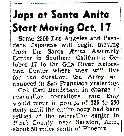 Edwardsville Intelligencer, June 24, 1942 |
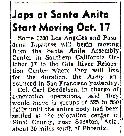 The Oakland Tribune, Oct. 7, 1942 |
Main Index
Japan main page
Japanese-American Internment Camps index page
Japan and World War II index page